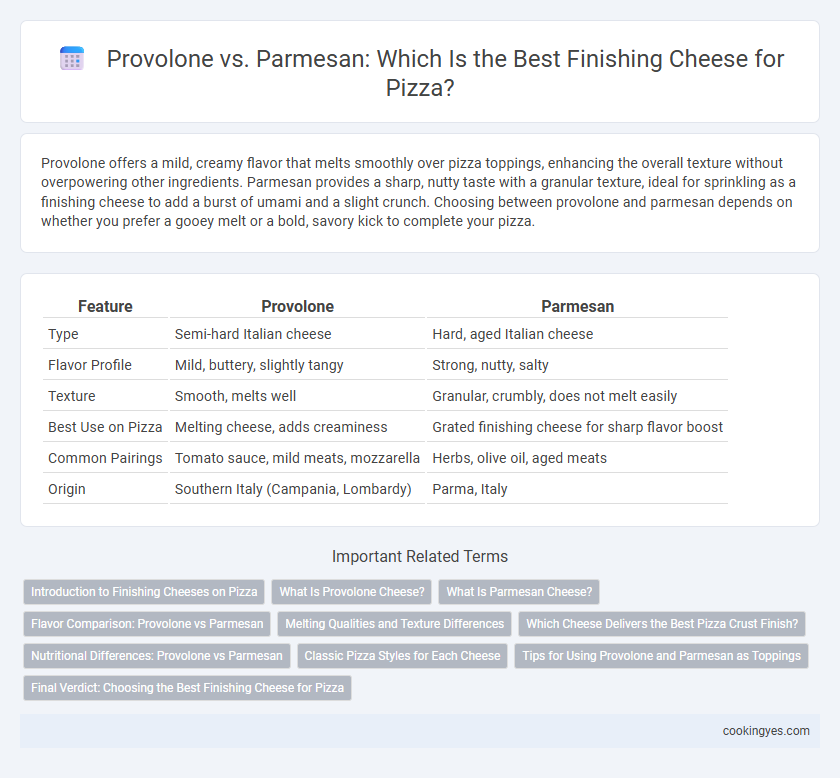Provolone offers a mild, creamy flavor that melts smoothly over pizza toppings, enhancing the overall texture without overpowering other ingredients. Parmesan provides a sharp, nutty taste with a granular texture, ideal for sprinkling as a finishing cheese to add a burst of umami and a slight crunch. Choosing between provolone and parmesan depends on whether you prefer a gooey melt or a bold, savory kick to complete your pizza.
Table of Comparison
| Feature | Provolone | Parmesan |
|---|---|---|
| Type | Semi-hard Italian cheese | Hard, aged Italian cheese |
| Flavor Profile | Mild, buttery, slightly tangy | Strong, nutty, salty |
| Texture | Smooth, melts well | Granular, crumbly, does not melt easily |
| Best Use on Pizza | Melting cheese, adds creaminess | Grated finishing cheese for sharp flavor boost |
| Common Pairings | Tomato sauce, mild meats, mozzarella | Herbs, olive oil, aged meats |
| Origin | Southern Italy (Campania, Lombardy) | Parma, Italy |
Introduction to Finishing Cheeses on Pizza
Provolone offers a smooth, mild flavor with excellent melting qualities, making it ideal for creating a creamy, cohesive finish on pizza. Parmesan delivers a bold, nutty, and salty profile with a granular texture, perfect for adding a sharp, savory punch as a finishing topping. Choosing between provolone and parmesan depends on whether a pizza calls for a rich, melty layer or a distinct, flavorful sprinkle to enhance the overall taste.
What Is Provolone Cheese?
Provolone cheese is a semi-hard Italian cheese known for its smooth texture and mild, slightly tangy flavor, making it a popular choice for finishing pizzas. It melts evenly without overpowering other ingredients, adding a creamy richness that complements tomato sauce and various toppings. Unlike Parmesan, which is dry and hard with a sharp, nutty taste, provolone provides a softer, more mellow finish ideal for those seeking a balanced cheese profile on their pizza.
What Is Parmesan Cheese?
Parmesan cheese, known as Parmigiano-Reggiano, is a hard, granular cheese originating from Italy, celebrated for its rich umami flavor and aged for a minimum of 12 months to develop its distinctive sharpness. It is commonly grated over pizza to enhance taste with its nutty, salty profile and firm texture that melts slightly but retains structure. Unlike provolone, which offers a mild, creamy melt, Parmesan provides a bold finishing touch that intensifies the overall flavor complexity of a pizza.
Flavor Comparison: Provolone vs Parmesan
Provolone offers a mild, creamy flavor with subtle tangy notes that melt smoothly on pizza, enhancing richness without overpowering other toppings. Parmesan delivers a sharper, nuttier, and saltier profile with granular texture, providing a distinct savory punch and umami boost when grated over finished pizzas. Choosing between Provolone and Parmesan depends on whether a softer, mellow finish or a bold, textured seasoning best complements the pizza's overall flavor.
Melting Qualities and Texture Differences
Provolone melts smoothly on pizza, creating a creamy, stringy texture that enhances each bite, while Parmesan offers a firmer, granular texture that resists melting and provides a sharp, nutty flavor burst. The higher moisture content in Provolone allows it to blend seamlessly with tomato sauce and dough, whereas Parmesan's drier consistency is ideal for sprinkling as a finishing cheese to add a savory crunch. Choosing between Provolone and Parmesan depends on whether the desired effect is a gooey, cohesive cheese layer or a textured, flavor-packed topping.
Which Cheese Delivers the Best Pizza Crust Finish?
Provolone cheese offers a smooth, creamy melt that enhances the pizza crust with a mild, slightly tangy flavor, making it ideal for a rich, luscious finish. Parmesan delivers a sharper, saltier taste and a granular texture that crisps up beautifully, adding a savory bite and extra crunch to the crust's edge. For a perfectly balanced pizza crust finish, Parmesan's robust flavor profile typically provides the best complement to the dough's crispiness.
Nutritional Differences: Provolone vs Parmesan
Provolone cheese contains approximately 98 calories and 7 grams of protein per ounce, with moderate calcium and lower sodium levels compared to Parmesan. Parmesan offers a higher protein content at around 10 grams per ounce, alongside more calcium--about 337 mg per serving--but also significantly increased sodium, often exceeding 400 mg. Choosing between Provolone and Parmesan for finishing pizza depends on prioritizing either lower sodium intake or maximizing protein and calcium content.
Classic Pizza Styles for Each Cheese
Provolone is traditionally favored for Classic Italian-American pizzas like the New York-style and Sicilian, where its mild, slightly tangy flavor melts smoothly and complements tomato sauce and mozzarella base. Parmesan, known for its sharp, nutty profile, is typically sprinkled on thin-crust Neapolitan or Margherita pizzas after baking to enhance the umami complexity without overpowering delicate fresh ingredients. Choosing provolone or parmesan as a finishing cheese depends on whether a creamy melt or a dry, granular texture and intense flavor boost best suits the pizza style.
Tips for Using Provolone and Parmesan as Toppings
Provolone offers a mild, creamy flavor and melts smoothly, making it ideal for topping pizzas where a rich, gooey texture is desired without overpowering other ingredients. Parmesan provides a sharp, nutty taste and a granular texture, perfect for sprinkling after baking to add a flavorful, salty finish that enhances umami. Use Provolone for a melty base layer and Parmesan as a finishing touch to balance richness with a burst of savory intensity.
Final Verdict: Choosing the Best Finishing Cheese for Pizza
Provolone offers a creamy, slightly tangy finish that melts smoothly, enhancing the overall flavor profile of a pizza without overpowering other ingredients. Parmesan delivers a sharp, nutty, and salty punch that crisps up beautifully when sprinkled on hot pizza, adding a robust umami boost. Choosing between Provolone and Parmesan depends on whether you prefer a melty, subtle finish or a bold, textured topping to elevate your pizza experience.
Provolone vs Parmesan for finishing cheese Infographic

 cookingyes.com
cookingyes.com